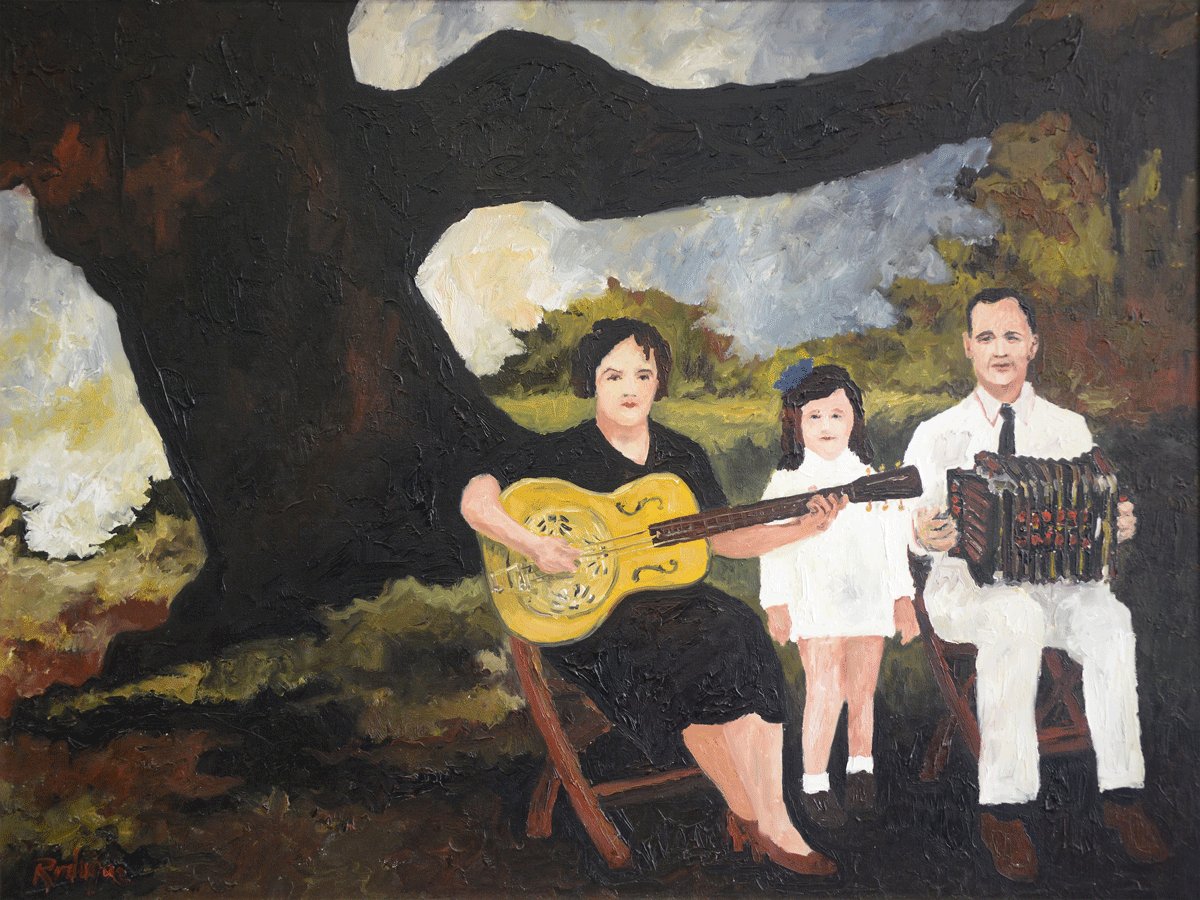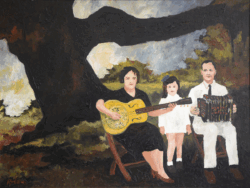Before the Blue Dog
George Rodrigue and the Cajun Revival
Published: December 1, 2024
Last Updated: February 28, 2025

George Rodrigue, Practice on a Sunday Afternoon, 1977. Oil on canvas.
George Rodrigue, Practice on a Sunday Afternoon, 1977. Oil on canvas.
Before George Rodrigue’s Blue Dog paintings catapulted him to international fame, the artist was already known for his dark, often ghostly depictions of Cajun landscapes and people. Rodrigue: Before the Blue Dog, a new exhibition at the Louisiana State Museum’s Cabildo, explores these sometimes overlooked works within the context of the Cajun Revival.
Born in 1944 in New Iberia, Rodrigue discovered painting at the age of nine, after a case of polio left him bedridden for six months. Hoping to entertain her son, Marie Courrege Rodrigue brought him a paint-by-number kit. Uninspired by the pre-designed image of the Last Supper, the young Rodrigue flipped the canvas over and painted things he knew—alligators, trees, and dogs—a harbinger of things to come.
After a stint at the ArtCenter College of Design in Los Angeles, Rodrigue returned to Louisiana in the late 1960s with a new appreciation of its distinctiveness. “Each time I’d come back to Louisiana,” Rodrigue explained, “I’d see something different that I hadn’t noticed growing up. . . . I saw all this stuff leaving us, things I wanted to capture in the Cajun country, and so I decided to call myself a Cajun artist.”
At first, Rodrigue focused on the natural world. He looked at other artists’ South Louisiana landscapes and realized that they followed the principles of eighteenth-century European design. As with his paint-by-number kit, Rodrigue chose to ignore the established lines. “The artists were missing the basic traits of South Louisiana, which are witchcraft, darkness, bayous, haunting feelings,” Rodrigue writes in the introduction to his 1976 book, The Cajuns of George Rodrigue.
“Each time I’d come back to Louisiana, I’d see something different that I hadn’t noticed growing up. . . . I saw all this stuff leaving us, things I wanted to capture in the Cajun country, and so I decided to call myself a Cajun artist.”
Eventually, Rodrigue began populating his landscapes with the people who lived there. Frequently painted in all white, his subjects often seem haunted or otherworldly. The white, Rodrigue explains, indicates hope, “for the people have to have hope for themselves” despite the hardships they face. Hovering between the sky and the ground, his Cajuns look like they are constrained “because they came to Louisiana, and they were locked in and they didn’t move.”
While his artistic vision was undeniably unique, Rodrigue’s interest in his Cajun roots was part of a broader cultural movement in the 1960s and 1970s, the Cajun Revival. Like Rodrigue, others of his generation sensed the passing of a distinctive culture and set out to document and revitalize its language, traditions, music, and food.
This revival not only increased ethnic pride among Cajuns but also created a new interest in Acadian culture outside the region. When, for example, Louisiana musicians such as Dewey Balfa introduced Cajun music to a national audience at the 1964 Newport Folk Festival in Rhode Island, they were met with standing ovations. Similarly, Paul Prudhomme’s penchant for blackening red fish led to a craze for Cajun-inspired cuisine across America.
Rodrigue: Before the Blue Dog explores how the artist’s work reflected and advanced this revival. The exhibit will be on view at the Louisiana State Museum’s Cabildo through September 25, 2025.

